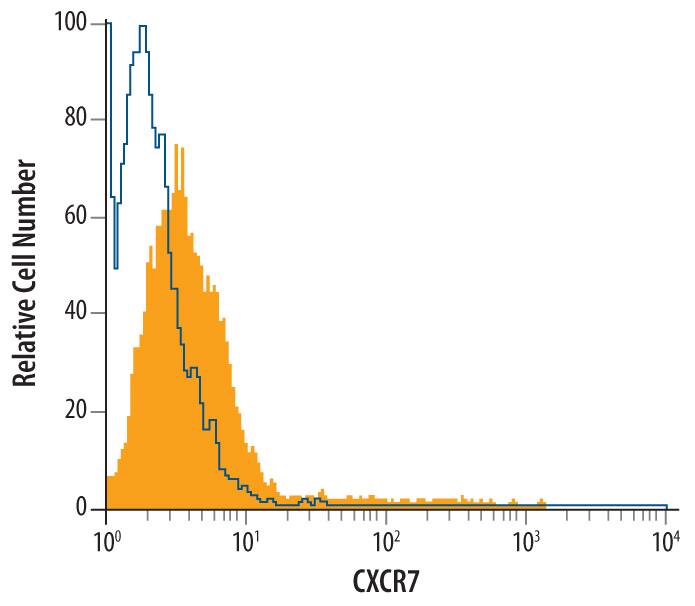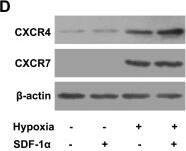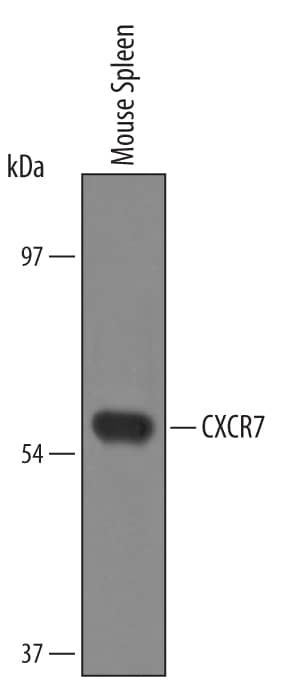Mouse CXCR7/RDC-1 Antibody
R&D Systems, part of Bio-Techne | Catalog # AF4227

Key Product Details
Validated by
Species Reactivity
Validated:
Cited:
Applications
Validated:
Cited:
Label
Antibody Source
Product Specifications
Immunogen
Met1-Leu47, Ser103-Lys118, Lys184-Glu213, and Leu274-Ala296
Accession # P56485
Specificity
Clonality
Host
Isotype
Scientific Data Images for Mouse CXCR7/RDC-1 Antibody
Detection of Mouse CXCR7/RDC‑1 by Western Blot.
Western blot shows lysates of mouse spleen tissue. PVDF Membrane was probed with 1 µg/mL of Mouse CXCR7/RDC-1 Antigen Affinity-purified Polyclonal Antibody (Catalog # AF4227) followed by HRP-conjugated Anti-Sheep IgG Secondary Antibody (Catalog # HAF016). A specific band was detected for CXCR7/RDC-1 at approximately 60 kDa (as indicated). This experiment was conducted under reducing conditions and using Immunoblot Buffer Group 8.Detection of CXCR7/RDC‑1 in Mouse Neural Progenitor Cells by Flow Cytometry.
Undifferentiated mouse neural progenitor cells were stained with Sheep Anti-Mouse CXCR7/RDC-1 Antigen Affinity-purified Polyclonal Antibody (Catalog # AF4227, filled histogram) or control antibody (Catalog # 5-001-A, open histogram), followed by NorthernLights™ 557-conjugated Anti-Sheep IgG Secondary Antibody (Catalog # NL010).Detection of Mouse CXCR7/RDC-1 by Western Blot
Effects of SDF-1-CXCR4/CXCR7 pathway on MSC chemotaxis in vitro.(A) The chemotaxis in response to SDF-1 alpha (10 ng/ml for 12 h) was performed in the NP-MSCs and HP-MSCs treated with a neutralizing anti-CXCR4 antibody, an anti-CXCR7 antibody, and the respective isotype-matched control antibodies. *P<0.05, vs NP-MSCs; †P<0.05, vs the respective isotype-matched control antibodies. (B) NP-MSCs were transiently overexpressed with CXCR4 using pORF9-mCXCR4 vector or with CXCR7 using pORF9-mCXCR7 vector (n = 6). A negative control empty (pORF9-MCS) vector was used. (C) The transfected cells were subjected to chemotaxis in response to the indicated concentrations of SDF-1 alpha for 12 h. *P<0.05, vs the empty vector. (D and E) Western blot analysis (D) and FCM (E) were performed to determine the intracellular and extracellular expression of both CXCR4 and CXCR7 in the cells treated with or without SDF-1 alpha (50 ng/ml for 60 min). (F) The chemotaxis in response to SDF-1 alpha was performed in the cells treated with or without SDF-1 alpha. Image collected and cropped by CiteAb from the following publication (https://pubmed.ncbi.nlm.nih.gov/22511954), licensed under a CC-BY license. Not internally tested by R&D Systems.Applications for Mouse CXCR7/RDC-1 Antibody
CyTOF-ready
Flow Cytometry
Sample: Undifferentiated mouse neural progenitor cells
Western Blot
Sample: Mouse spleen tissue
Formulation, Preparation, and Storage
Purification
Reconstitution
Formulation
Shipping
Stability & Storage
- 12 months from date of receipt, -20 to -70 °C as supplied.
- 1 month, 2 to 8 °C under sterile conditions after reconstitution.
- 6 months, -20 to -70 °C under sterile conditions after reconstitution.
Background: CXCR7/RDC-1
CXCR7 (CXC chemokine receptor 7; also GPRN1, RDC1 and chemokine orphan receptor 1) is a 60 kDa member of the G-protein coupled receptor 1 family. It is expressed on multiple cell types, including neurons, T cells, NK cells, neutrophils, B cells plus angiogenic endothelial cells. CXCR7 forms both homodimers and heterodimers with CXCR4. It selectively binds I-TAC and SDF1, and appears to involve beta-arrestin2 during signaling. Notably, a CXCR7:CXCR4 heterodimer shows increased responsiveness to SDF1, and I-TAC may actually block some SDF1-mediated migration activity. Mouse CXCR7 is a 7-transmembrane glycoprotein that is 362 amino acids (aa) in length. It contains a 47 aa N-terminal extracellular region plus a 43 aa C-terminal cytoplasmic domain. Over aa 1‑47, 103‑118, 184‑213 and 274‑296 collectively, mouse CXCR7 shares 97% and 91% aa identity with rat and human CXCR7, respectively.
Alternate Names
Gene Symbol
UniProt
Additional CXCR7/RDC-1 Products
Product Documents for Mouse CXCR7/RDC-1 Antibody
Product Specific Notices for Mouse CXCR7/RDC-1 Antibody
For research use only


